
Pontiac, or formally the Pontiac Motor Division of General Motors, was an American automobile brand owned, manufactured, and commercialized by General Motors. It was originally introduced as a companion make for GM's more expensive line of Oakland automobiles. Pontiac quickly overtook Oakland in popularity and supplanted its parent entirely by 1933, in turn establishing its position as one of GM's dominant divisions.

The Chevrolet Bel Air is a full-size car produced by Chevrolet for the 1950–1981 model years. Initially, only the two-door hardtops in the Chevrolet model range were designated with the Bel Air name from 1950 to 1952. With the 1953 model year, the Bel Air name was changed from a designation for a unique body shape to a premium level of trim applied across a number of body styles. The Bel Air continued with various other trim level designations, and it had gone from a mid-level trim car to a budget fleet sedan when U.S. production ceased in 1975. Production continued in Canada, for its home market only, through the 1981 model year.
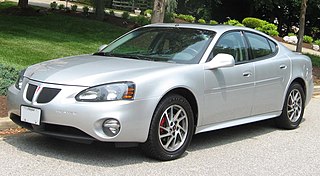
The Grand Prix is a line of automobiles produced by the Pontiac Division of General Motors from 1962 until 2002 as coupes and from 1989 through 2008 model years as four-door sedans.

The Pontiac Catalina is a full-size, junior series automobile produced by Pontiac from 1950 to 1981. Initially, the name was a trim line on hardtop body styles, first appearing in the 1950 Chieftain Eight and DeLuxe Eight lines. In 1959, it became a separate model as the "entry-level" full-size Pontiac.

The Pontiac Bonneville is a model line of full-size or mid-size front-engine rear drive cars manufactured and marketed by Pontiac from 1957 until 2005, with a hiatus for model years 1982-1986.

The Chevrolet Lumina APV is a minivan that was produced by the Chevrolet division of General Motors. The first front-wheel drive minivan sold by Chevrolet, the Lumina APV was sold in a single generation from the 1990 to 1996 model years. Marketed alongside the Pontiac Trans Sport and Oldsmobile Silhouette, the Lumina APV competed against the Dodge Grand Caravan/Plymouth Grand Voyager, the extended-length Ford Aerostar, and the Mazda MPV.

The General Motors Motorama was an auto show staged by GM from 1949 to 1961. These automobile extravaganzas were designed to whet public appetite and boost automobile sales with displays of fancy concept cars and other special or halo models. Motorama grew out of Alfred P. Sloan's yearly industrial luncheons at New York City's Waldorf-Astoria Hotel, beginning in 1931. They were almost invariably held in conjunction with the New York Auto Show, that for many years was held traditionally in the first week of January.

The Pontiac Parisienne is a full-size rear-wheel drive vehicle that was sold by Pontiac on the GM B platform in Canada from 1958 to 1986 and in the United States from 1983 to 1986. Right-hand drive models were locally assembled in Australia, New Zealand, and South Africa until 1969. For most of its run, the Canadian Parisienne was nearly mechanically identical to the American Chevrolet Impala or Chevrolet Caprice. The Parisienne wagon continued under the Safari nameplate until 1989. Parisienne or La Parisienne means a grammatically female person or thing from Paris, France.
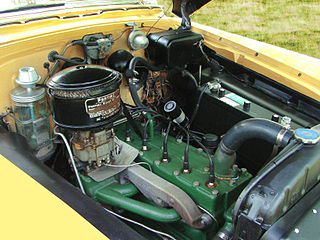
The Pontiac straight-8 engine is an inline eight-cylinder automobile engine produced by Pontiac from 1933 to 1954. Introduced in the fall of 1932 for the 1933 models, it was Pontiac's most powerful engine at the time and the least expensive eight-cylinder engine built by an American automotive manufacturer. During its 21-year run displacement of the "eight" increased twice as platforms grew. It was superseded by Pontiac's new V8, the 287, in 1955. Engine block and cylinder heads were cast at Saginaw Metal Casting Operations then assembled at Tonawanda Engine before delivery to Pontiac Assembly for installation.

The Pontiac Safari is a line of station wagons that was produced by Pontiac from 1955 to 1989. Initially introduced as the Pontiac counterpart of the two-door Chevrolet Nomad, the division adopted the nameplate across its full-size wagon range in 1957. Through its production, the Safari was positioned between Chevrolet full-size station wagons and below its Buick and Oldsmobile counterparts. During the mid-1960s, the Safari added simulated woodgrain trim to the exterior, becoming a feature associated with the model line.
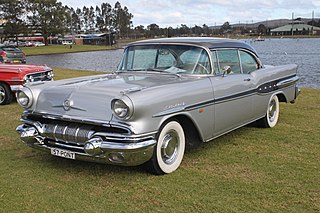
The Pontiac Star Chief is an automobile model which was manufactured by Pontiac between 1954 and 1966. It was Pontiac's top trim package on the Pontiac Chieftain, with later generations built on longer wheelbases, and serving as the foundation platform for the Pontiac Bonneville. The car was easily identified by its chrome star trim along its sides, a feature all Star Chiefs were equipped with.
The Pontiac Banshee is a line of concept cars designed by Pontiac, assuming the role previously established by General Motors' Firebirds of the 1950s. Four Banshee "dream cars" were fabricated through 1988 as design exercises intended to establish exterior and interior themes that could be modified for production versions of Pontiac sports and performance cars. Banshee was also the leading candidate for Pontiac's version of the Camaro before being named Firebird in light of any deathly associations of the word Banshee.

The Pontiac Chieftain is an automobile which was produced by Pontiac from 1949 to 1958. The 1949 Chieftain and Streamliner models were the first all new car designs to come from Pontiac in the post World War II years. Previous cars had been 1942 models with minor revisions.

Chevrolet Nomad is a nameplate used by Chevrolet in North America from the 1950s to the 1970s, applied largely to station wagons. Three different Nomads were produced as a distinct model line, with Chevrolet subsequently using the name as a trim package.
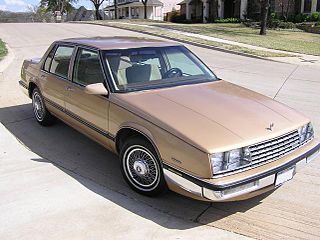
The H platform, or H-body designates a General Motors front-wheel-drive full-sized car platform introduced in 1986, and in most respects identical to the front-drive C platform introduced for model year 1985. Originally available in both 2-door and 4-door versions — the latter was more popular and two-door models dropped by 1992. Engines were predominantly the Buick's 3.8 liter V6 engine and later, GM's Buick 3800 V6; in naturally aspirated and supercharged variants.

The Pontiac Bonneville Special is a concept car unveiled at the General Motors Motorama in 1954, the first two-seat sports car prototype the division had ever produced. Conceived by renowned designer Harley J. Earl and hand-built by Homer C. LaGassey Jr. and Paul Gilland, the "Special" is a grand touring sport coupé that incorporated innovative styling like a Plexiglas canopy with gull-wing windows on a sleek fiberglass body.

The Pontiac Torpedo was a full-sized car produced by Pontiac from the 1940 through the 1948 model year. When released, it was the biggest Pontiac, used an 8-cylinder engine, and it had more standard features than other Pontiacs. Although the Torpedo name was exclusive to the highest line of Pontiacs in 1940, in 1941 the name was applied to all Pontiacs in three separate lines. The Custom Torpedoes were now top-of-the-line name, while the DeLuxe Torpedo became the base line, and the Streamline Torpedo became the middle line of Pontiacs. All Torpedo models could be had with either a 6-cylinder or 8-cylinder engine beginning in 1941. From 1942 to 1948 the Torpedo name designated only the base line of Pontiacs. The Torpedo was replaced by the Pontiac Chieftain in 1949. It was with this generation that all GM vehicles experienced increased width dimensions to accommodate three passengers on the front bench seat and an additional three passengers on rear bench seat installed vehicles. This was accomplished with the deletion of running board thereby adding additional room inside the passenger compartment.
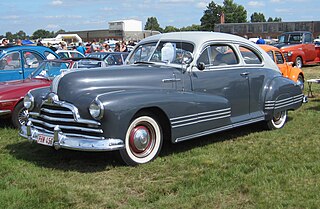
The Pontiac Streamliner is a full-size car produced under the Pontiac brand by General Motors from 1932 until 1952. A mass-produced and popular vehicle, it was a significant luxury car during the recovery from the Great Depression, and during and immediately after the Second World War.

The Oldsmobile Golden Rocket was a two-seater show car built by Oldsmobile for the 1956 General Motors Motorama. The radically styled fiberglass concept, designed to resemble a rocket on wheels, was revised several times and displayed at various other auto shows, most notably at the 1957 Paris Motor Show where it generated much fanfare, 18 months after it was first revealed. The car was featured in the promotional short film Design for Dreaming along with the rest of the 1956 General Motors lineup.


















